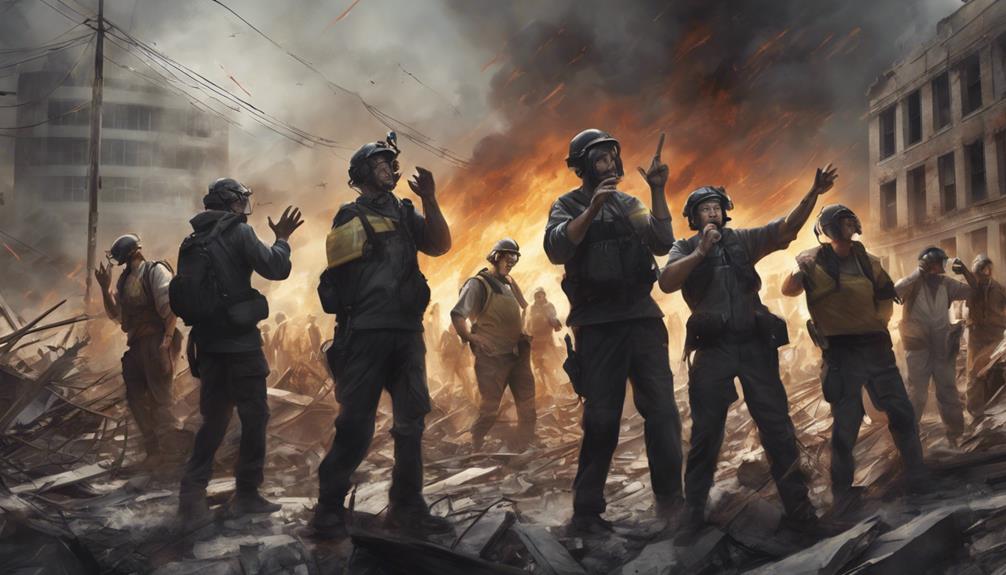Effective communication during disasters is not just a matter of convenience; it can be the difference between life and death. The methods and tools we employ to convey critical information swiftly and accurately can determine the outcome of an emergency situation. From the integration of tech-savvy solutions to reliance on traditional means, the communication landscape during a crisis is multifaceted and dynamic. Understanding the nuances of communication strategies, pitfalls to avoid, and best practices is imperative for all individuals and organizations involved in disaster response. How we navigate this intricate web of communication channels can ultimately shape the outcome of a crisis.
Key Takeaways
- Establish reliable communication channels for efficient disaster response.
- Designate out-of-town contacts and practice family communication plans.
- Utilize emergency alert systems like WEAs and IPAWS for swift alerts.
- Maintain and backup communication equipment for continuous connectivity.
Importance of Communication in Disasters
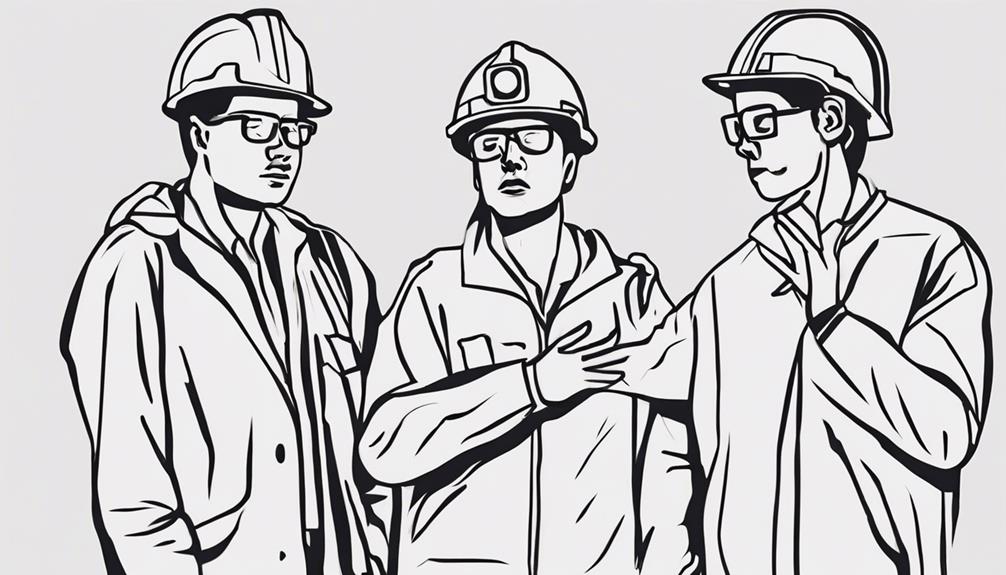
Effective communication plays a pivotal role in disaster response by facilitating coordination, reducing confusion, and enhancing overall efficiency. During emergencies, clear and timely communication is crucial for disseminating information, ensuring the safety of individuals, and making informed decisions. In a disaster scenario, effective communication channels enable authorities to swiftly reach out to the public, emergency responders, and other relevant stakeholders. The ability to establish reliable lines of communication, including protocols for contact and information sharing, is fundamental to managing a crisis effectively. By having robust communication systems in place, organizations can streamline response efforts, allocate resources efficiently, and provide necessary instructions to those impacted by the disaster. Therefore, investing in communication infrastructure, training personnel on communication equipment, and establishing clear protocols for dissemination of information are essential components of disaster preparedness and response strategies. In essence, communication acts as the backbone of successful emergency management, ensuring a coordinated and effective response when disaster strikes.
Establishing a Family Communication Plan
To ensure readiness and effective coordination during times of crisis, developing a comprehensive family communication plan is paramount. This plan should designate an out-of-town contact that all family members can check in with, as local lines may be overwhelmed during emergencies. It is crucial to identify multiple communication methods such as text, calls, social media, and email to ensure flexibility in reaching everyone. Additionally, establishing meeting points both nearby and outside the neighborhood is essential for reunification after a disaster strikes. Including important medical information and emergency contacts in each family member's contact card can also aid first responders in providing necessary care promptly. Regularly practicing the communication plan is vital to ensure that all family members are familiar with their roles and responsibilities, increasing the plan's effectiveness when it is most needed. By proactively creating and rehearsing a family communication plan, everyone can be better prepared to handle unexpected situations and stay connected during emergencies.
Utilizing Wireless Emergency Alerts (WEAs)
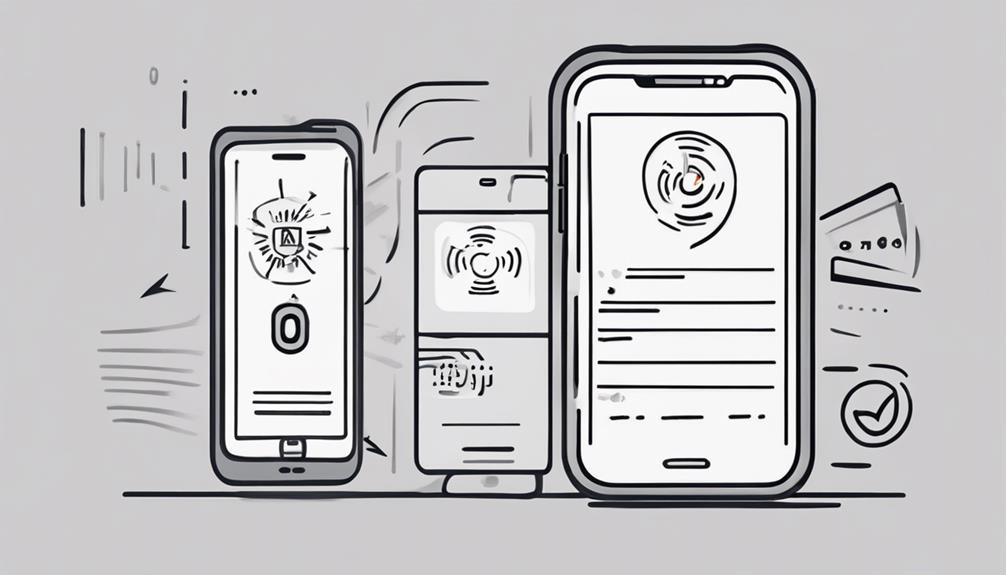
In light of the importance of establishing a comprehensive family communication plan for readiness during disasters, an additional tool that can significantly enhance communication effectiveness is the utilization of Wireless Emergency Alerts (WEAs). These emergency alerts are sent by authorized government alerting authorities through cell towers to compatible cell phones. WEAs cover a range of alerts including extreme weather, local emergencies requiring evacuation, AMBER alerts, and Presidential alerts. They are free, can be sent nationwide, and do not require users to sign up or subscribe. However, due to the limited character count of 90, including the message, issuing agency, and any required action, the information in WEAs must be concise and to the point. Integrated into the broader system of the Integrated Public Alert and Warning System (IPAWS), WEAs play a crucial role in emergency management by ensuring that the public is promptly informed and prepared during disasters and emergencies. The effectiveness of these alerts highlights the significance of incorporating modern communication systems into comprehensive emergency management strategies.
Role of Integrated Public Alert System
How does the Integrated Public Alert System contribute to the efficient dissemination of emergency information across various communication channels? The role of the Integrated Public Alert and Warning System (IPAWS) is crucial in enhancing public safety and ensuring effective emergency communication. Here are four key ways IPAWS achieves this:
- Integration of Alerting Systems: IPAWS integrates various alerting systems such as Wireless Emergency Alerts (WEAs) and Emergency Alert System (EAS) to reach a wide audience through different communication channels.
- Rapid Communication: Authorized public safety officials can swiftly send emergency messages to compatible devices using IPAWS, ensuring timely dissemination of critical information.
- Enhanced Public Awareness: By broadcasting alerts on TV, radio, cell phones, and other devices, IPAWS enhances public awareness during emergencies, promoting a quicker and more informed response.
- Improved Coordination: IPAWS facilitates coordination among different alerting authorities at federal, state, local, tribal, and territorial levels, ensuring consistent and timely emergency notifications across the board.
Accessing NOAA Weather Radio
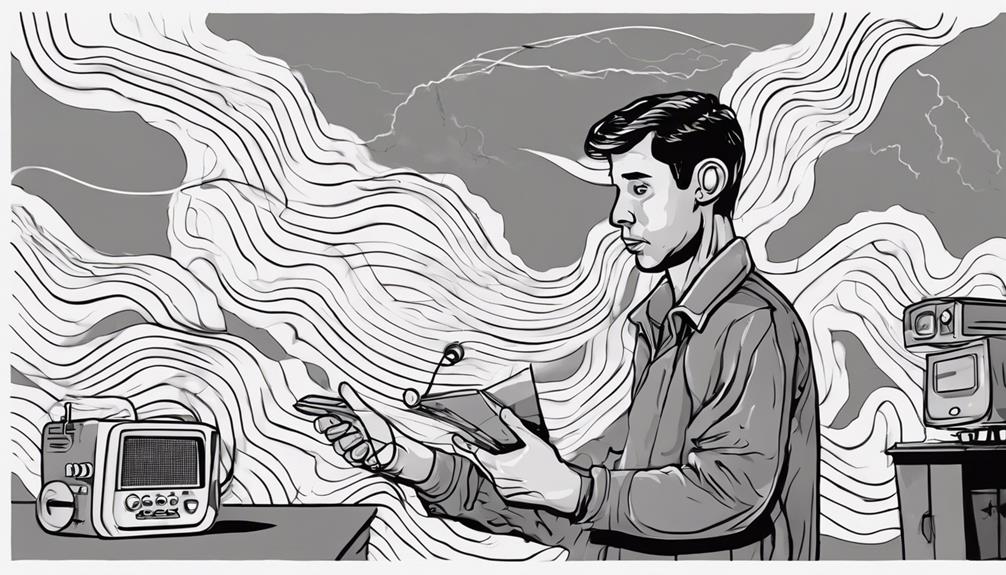
Accessing NOAA Weather Radio serves as a vital resource for individuals seeking real-time weather updates and emergency information directly from the National Weather Service. This radio broadcasts continuous weather information and provides alerts on severe weather conditions, forecasts, and emergency updates. Operating 24/7, NOAA Weather Radio covers various frequencies to ensure accurate and timely communication. By tuning in to specific channels based on their location, users can receive localized weather reports, which can be crucial during disasters like hurricanes, tornadoes, and severe storms. Emergency personnel can also use NOAA Weather Radio to stay informed and make informed decisions to protect lives and property. In times of crisis, having access to NOAA Weather Radio can be a lifeline for communities, offering crucial information that can help individuals prepare and respond effectively. For local emergency updates and specific frequencies, individuals can refer to phone numbers provided by their local emergency management agencies.
Leveraging Shortwave Radio
Utilizing shortwave radio technology enhances disaster communication capabilities by providing long-distance reach and reliable independent communication channels. Shortwave radio operates on frequencies between 1.6 to 30 MHz, allowing for long-distance communication during disasters. Here are key points to consider when leveraging shortwave radio during emergencies:
- Long-Distance Reach: Shortwave radio transmissions can travel over thousands of miles, making it ideal for reaching affected areas with limited infrastructure.
- Reliable Independent Communication: Many emergency services and organizations use shortwave radio for reliable and independent communication when other methods are unavailable.
- Communication Continuity: Shortwave radios are portable and can be powered by various sources like batteries, solar panels, or hand-crank generators, ensuring communication continuity.
- Role of Amateur Operators: Shortwave radio enthusiasts and amateur operators play a significant role in disaster response by providing crucial communication links during emergencies.
Leveraging shortwave radio not only offers a robust communication solution during disasters but also highlights the importance of amateur operators in maintaining communication networks in times of crisis.
Significance of Two-Way Radios
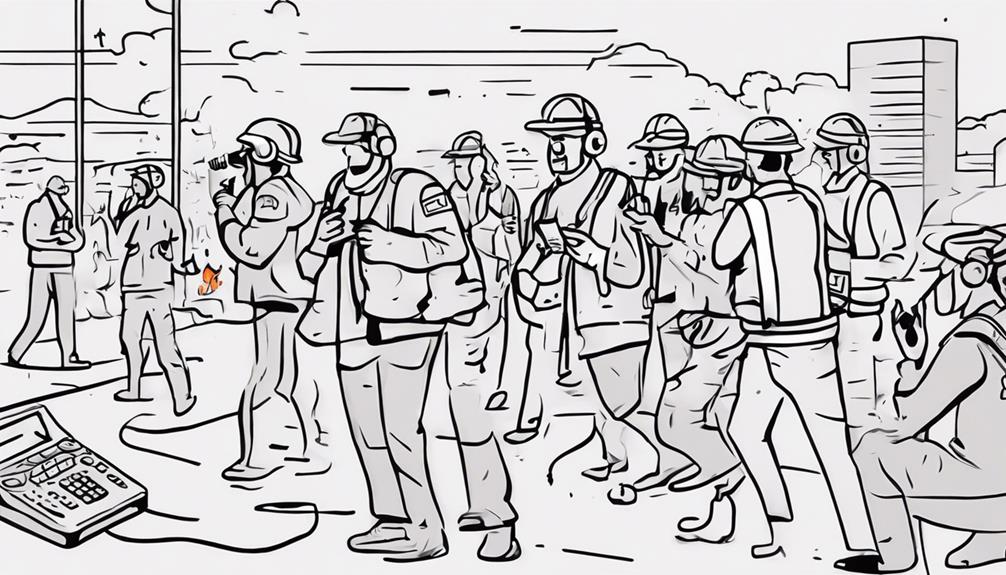
The significance of two-way radios in disaster communication strategies lies in their reliability and ability to facilitate direct coordination among responders in challenging environments. Two-way radios serve as essential tools during emergencies, offering a dependable means of communication when other methods may not be feasible. These devices enable emergency contacts to be established swiftly, allowing for efficient information sharing and decision-making among response teams. While two-way radios may have limitations in range due to factors such as terrain and interference, they remain accessible for personal use and play a vital role in disaster communication protocols. Common types of two-way radios include the Family Radio Service (FRS) and General Mobile Radio Service (GMRS) radios, each serving specific communication needs. Licensing requirements for higher transmission power on GMRS frequencies ensure regulatory compliance, while ham radios provide extended range and enhanced reliability for critical communication purposes. In essence, the versatility and direct line of communication offered by two-way radios make them indispensable assets in disaster response efforts.
Emergency Communication via Phones
Emergency communication via phones plays a vital role in disaster situations, with phone call accessibility being a primary feature for connecting individuals with emergency services and loved ones. Text message alerts serve as valuable tools for disseminating critical information swiftly and efficiently to a large audience. The reliability of data networks becomes essential during emergencies, ensuring that communication channels remain open and accessible for coordination and support.
Phone Call Accessibility
During disasters, maintaining phone call accessibility for emergency communication is crucial for ensuring effective communication channels are available. Here are some key considerations for ensuring phone call accessibility during emergencies:
- Utilize Landline Phones: Due to their physical connection, landline phones are more reliable during disasters, often working when cell networks are down.
- Call Out-of-State Contacts: Contacting out-of-state contacts can help avoid local phone line congestion and increase the chances of successful communication.
- Prioritize Text Messages: Text messages are more likely to go through during emergencies compared to voice calls, as they require less network bandwidth.
- Use Portable Battery Backups: Portable battery backups for cell phones are essential to ensure continued communication when power sources are unavailable.
Text Message Alerts
Ensuring efficient communication channels during disasters is paramount, with text message alerts serving as a vital tool for quick and widespread emergency communication via phones. Text message alerts provide quick, concise information, reaching a large number of people simultaneously. During disasters, when networks are congested, text messages are more likely to be received than phone calls. These emergency alerts play a crucial role in conveying instructions, warnings, and safety information to the public. The effectiveness of text message alerts lies in their ability to facilitate mass communication and disseminate urgent updates efficiently. As a method of communication, text message alerts are essential components of the emergency alert system (EAS) for ensuring timely and critical information reaches individuals via their cell phones.
Data Network Reliability
In the realm of disaster communication, the reliability of data networks becomes a critical factor in ensuring effective emergency communication via phones. During disasters, cell phones may heavily depend on data networks, which can face challenges like network congestion and outages, impacting communication. To navigate this, understanding the limitations of data networks and having alternative communication methods are vital. Wireless carriers prioritize emergency calls to guarantee essential communication during crises. Moreover, backup power sources such as power banks play a crucial role in keeping phones connected to data networks in case of power failures. These measures collectively contribute to maintaining connectivity to emergency services, receiving important updates, and staying in touch with family and friends amidst disasters.
- Data networks can be affected by network congestion and outages during disasters.
- Understanding data network limitations is crucial for reliable communication.
- Wireless carriers prioritize emergency calls to ensure critical communication.
- Backup power sources like power banks are essential for connectivity during power outages.
Ensuring Backup Power for Devices
To maintain communication capabilities during a disaster, it is essential to have reliable backup power sources for electronic devices. Backup power options such as power banks, hand crank generators, solar chargers, and car chargers play a crucial role in ensuring that essential communication devices remain charged and operational when traditional power sources are unavailable. Additionally, having a designated In Case of Emergency (ICE) contact stored in your phone can facilitate access to critical information even in situations where power is limited. Storing emergency plans, important contacts, and downloading relevant emergency apps on your phone can further aid in staying connected during power outages. These proactive measures can significantly enhance communication resilience during times of crisis, enabling individuals to reach out for help, coordinate with loved ones, and access vital information when traditional communication channels may be disrupted. By incorporating backup power sources and emergency communication strategies into disaster preparedness plans, individuals can better equip themselves to navigate challenging circumstances and communicate effectively during emergencies.
Safeguarding Communication Equipment
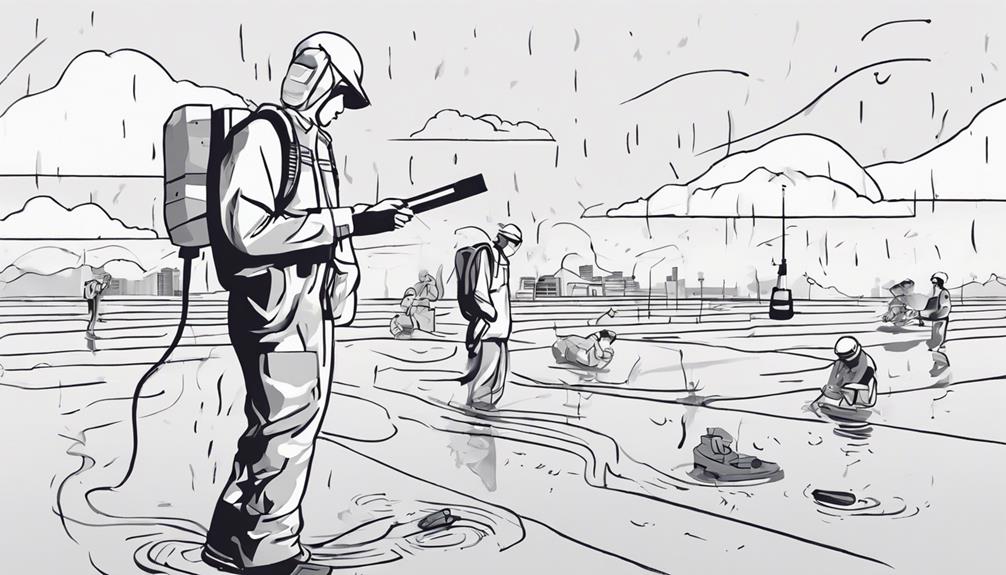
To ensure effective communication during disasters, it is crucial to safeguard communication equipment. This can be achieved by implementing equipment maintenance tips and having backup communication plans in place. By following these strategies, individuals and organizations can maintain reliable communication channels even in challenging circumstances.
Equipment Maintenance Tips
Regular inspection and maintenance of communication equipment is essential to ensure reliable functionality and readiness during critical situations. To safeguard communication equipment effectively, consider the following maintenance tips:
- Regular Inspections: Check for damage or wear regularly to maintain optimal functionality.
- Cleaning: Clean and dust equipment frequently to prevent performance-affecting buildup.
- Proper Storage: Store devices in protective cases to prevent damage from impact and environmental factors.
- Battery Care: Follow manufacturer guidelines for battery care to extend equipment lifespan.
Additionally, keeping spare parts, batteries, and accessories on hand allows for quick replacements in case of failures during a disaster. These practices help maintain communication equipment in peak condition for crucial communication needs.
Backup Communication Plans
For effective communication readiness during disasters, establishing robust backup communication plans is imperative to safeguard communication equipment and ensure continuity in critical situations. Safeguarding communication devices can be achieved by using protective cases and waterproof coverings to shield them from environmental hazards. Emergency kits should include spare batteries, power banks, chargers, and any necessary accessories to keep cell phones and radios operational. Additionally, incorporating Faraday cages or bags in emergency preparedness can protect communication devices from electromagnetic pulses (EMP) and geomagnetic disturbances (GMD). Regularly testing backup communication plans is essential to verify functionality and readiness in case of emergencies, ensuring that communication remains reliable when needed most.
Crisis Communication Barriers
During emergencies, the presence of stress and technological disruptions can significantly impede the effectiveness of communication efforts, leading to potential confusion and misinformation among affected individuals.
Crisis Communication Barriers:
- Stress and Panic: High levels of stress and panic during a disaster can hinder clear communication and decision-making processes.
- Technology Failures: Disrupted communication infrastructure, overloaded networks, or power outages can create barriers to accessing and disseminating critical information.
- Timeliness: Delays in delivering accurate information can exacerbate confusion and impede swift response efforts, highlighting the importance of timely communication.
- Language and Cultural Differences: Varied languages spoken and cultural differences among affected populations can pose challenges in effectively conveying messages and instructions during a crisis.
Addressing these barriers is crucial for enhancing communication resilience during disasters and ensuring that accurate information reaches those in need efficiently.
Engaging With the Media Effectively
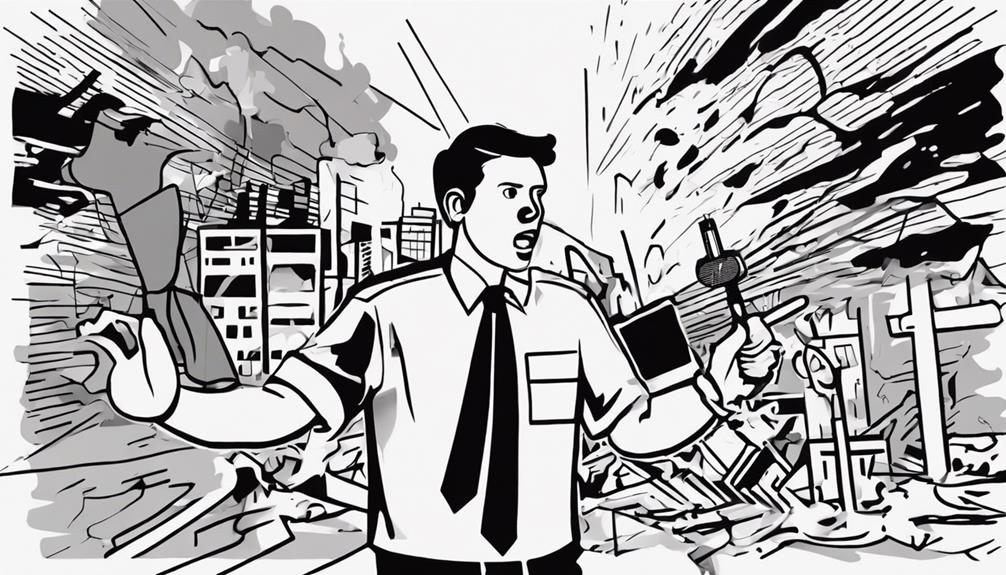
Effective engagement with the media is crucial during disasters to ensure accurate information is disseminated to the public. By forming partnerships with media outlets and preparing clear statements, organizations can address public concerns and provide timely updates. Utilizing various media platforms and training spokespersons are key strategies to reach a broader audience and maintain transparency during crises.
Media Engagement Strategies
Establishing strong media engagement strategies is essential for effective communication during disasters. To engage with the media efficiently, consider the following strategies:
- Establish Media Partnerships: Collaborate with media outlets to enhance information dissemination.
- Prepare Clear Statements: Develop concise media statements for quick and accurate updates during a crisis.
- Utilize Various Platforms: Use radio, TV, and social media to reach a wider audience effectively.
- Train Spokespersons: Provide designated individuals with media training to ensure effective communication with journalists.
Crisis Communication Tips
In navigating crisis communication, adeptly engaging with the media is crucial for ensuring timely and accurate information dissemination. To effectively communicate during a crisis, forming partnerships with media outlets, preparing clear media statements, and utilizing diverse platforms like press releases and social media are essential. Training designated spokespersons in crisis communication strategies ensures consistency and credibility in messaging. Establishing protocols for media engagement enhances public understanding and coordination. Engaging with radio services such as FRS, Amateur Radio, and the National Weather Service can also broaden reach during emergencies. By following these crisis communication tips and utilizing various media platforms, organizations can maintain transparency, manage public expectations, and facilitate efficient response efforts.
| Media Engagement Strategies | Advantages | Challenges |
|---|---|---|
| Partnerships with media outlets | – Accurate information dissemination <br> – Broad outreach | – Potential for misinformation <br> – Dependence on external sources |
| Clear media statements | – Effective communication <br> – Key message delivery | – Time-consuming preparation <br> – Misinterpretation risks |
| Utilizing diverse platforms | – Enhanced public engagement <br> – Wider dissemination | – Platform-specific limitations <br> – Coordination complexities |
Evaluating and Updating Communication Plans
Regularly assessing and updating communication plans is crucial in enhancing the responsiveness and effectiveness of disaster communication strategies. To ensure that communication plans are robust and adaptive, the following steps can be taken:
- Review Past Disasters: Learn from previous experiences by analyzing what worked well and what could be improved in terms of communication strategies during disasters.
- Evaluate Effectiveness: Assess how well the communication strategies performed in past disaster responses to identify areas for enhancement.
- Seek Feedback: Engage with stakeholders and community members to gather insights on how communication can be better tailored to meet their needs during disasters.
- Identify Gaps: Conduct a thorough examination of existing communication protocols to pinpoint any weaknesses or deficiencies that need to be addressed promptly.
Frequently Asked Questions
What Is the Best Way to Communicate in a Disaster?
The best way to communicate in a disaster is through a multifaceted approach utilizing various tools. Emergency contacts provide direct communication for immediate assistance. Text alerts offer timely updates to a wide audience. Social media platforms enable real-time information sharing and safety checks. Radio broadcasts are effective for on-site coordination and quick dissemination of critical information. By combining these communication channels, a comprehensive system can be established to ensure effective communication during a disaster.
What Is the Communication Protocol During a Disaster?
During an emergency response, a structured communication plan is critical for crisis communication. Establishing clear roles, utilizing effective information sharing methods, and coordinating with relevant agencies are key components. Implementing a robust communication protocol ensures timely and accurate dissemination of information to all stakeholders. By prioritizing communication strategies tailored to diverse audiences, inclusivity and efficiency in response efforts can be achieved. How can these elements be integrated effectively to enhance disaster communication protocols?
What Is Communication Strategy in Disaster?
In emergency response and disaster management, communication tactics are vital for ensuring effective crisis communication. A well-defined communication strategy outlines protocols, roles, and responsibilities for coordinating response efforts. Interagency collaboration is crucial to facilitate coordination among different response agencies. Public communication strategies are essential for disseminating accurate information to diverse audiences. Incorporating non-verbal communication techniques, language considerations, and cultural inclusivity enhances the overall effectiveness of communication during disasters.
What Is an Example of Disaster Communication?
During a disaster, effective emergency alerts through social media platforms play a crucial role in disseminating critical information to the public. Additionally, traditional communication channels such as radio and television, along with community outreach initiatives like phone trees, are vital in reaching a wider audience. Public address systems and sirens are also essential tools for alerting communities during emergencies, ensuring swift and coordinated responses.
Conclusion
In conclusion, effective communication is essential in disaster situations to ensure safety and coordination of response efforts. By establishing communication plans, utilizing various technologies, and addressing potential barriers, communities can enhance their preparedness and response capabilities. However, are we truly prepared to face the challenges of communication during disasters? Regular evaluation and updates to communication strategies are crucial in order to adapt to evolving threats and ensure effective communication when it matters most.
